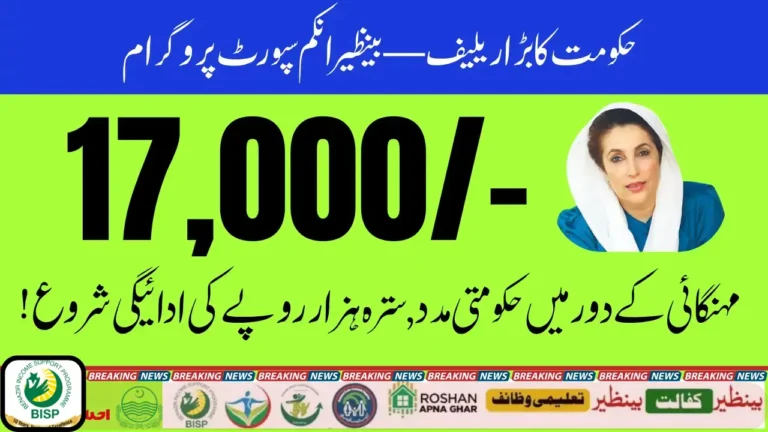BISP Budget 2025-26 Increased – Government’s New Plan Explained
The Government of Pakistan has announced that the BISP Budget 2025-26 Increased by 20%, marking a decisive step toward strengthening social welfare programs in the country. This increase demonstrates the administration’s commitment to supporting low-income families and mitigating the impact of inflation on vulnerable households. With the updated allocation, millions of families are expected to benefit from more substantial financial assistance, ensuring they can meet essential needs such as food, education, and healthcare.
Since its inception, the Benazir Income Support Program has been a cornerstone of Pakistan’s social safety net. The program has provided cash transfers to marginalized communities, giving them a financial cushion against poverty. By increasing the BISP budget, the government aims to enhance the effectiveness of these transfers and ensure that the program continues to deliver tangible benefits for those who need it most.
 Also read
Also read
Overview of the BISP Budget 2025-26
The BISP Budget 2025-26 Increased from Rs. 598 billion in the previous fiscal year to Rs. 716 billion. This rise allows the program to maintain support for its current beneficiaries while expanding its reach to include more families. The quarterly stipend has been raised to Rs. 14,500, reflecting an effort to counteract inflation and improve the purchasing power of households relying on BISP.
| Budget Feature | Details |
|---|---|
| Total Allocation | Rs. 716 billion |
| Increase from Previous Year | 20% |
| Quarterly Stipend | Rs. 14,500 |
| Current Beneficiary Households | 10 million |
| Projected New Enrollments | 700,000 |
Reasons Behind the Budget Increase
The decision to increase BISP funding stems from the need to address economic challenges faced by low-income households. Rising inflation and living costs have diminished the real value of previous cash transfers. By expanding the budget, the government ensures that beneficiaries can continue meeting basic necessities without additional financial strain.
 Also read
Also read
Expanding Beneficiary Coverage
With the BISP Budget 2025-26 Increased, the program will sustain support for 10 million households while enrolling an estimated 700,000 new families. This expansion is crucial for reaching previously underserved communities and extending financial aid to households that were on the margins of the social protection system.
Conditional Cash Transfer Initiatives
BISP is also focusing on linking financial assistance with outcomes in education, health, and nutrition. Conditional Cash Transfer programs aim to encourage families to engage in activities such as regular school attendance or routine medical checkups. These initiatives promote long-term development, helping beneficiaries improve their living standards beyond immediate financial support.
 Also read
Also read
Targeted Subsidies and Efficient Resource Allocation
The government is aligning BISP with broader subsidy reforms by targeting financial aid to households that need it most. This approach ensures resources are efficiently utilized and prevents funds from being spent on households that do not require assistance. Targeted subsidies improve the program’s overall impact and increase equity in social welfare distribution.
Digital Payments and Financial Inclusion
As part of modernization efforts, BISP is introducing digital payment solutions to enhance transparency and ensure timely delivery of benefits. Direct transfers to bank accounts or mobile wallets reduce delays and foster financial inclusion, allowing beneficiaries to participate in the formal financial system.
 Also read
Also read
Monitoring and Accountability
Strengthened monitoring mechanisms will accompany the BISP Budget Increased, ensuring that program funds are effectively utilized. Regular evaluations will measure impact on poverty reduction and enable adjustments where necessary. Feedback channels will also empower beneficiaries to report issues and contribute to program improvements.
Collaboration with Provincial Authorities
Effective coordination between federal and provincial governments is key to maximizing BISP’s impact. By harmonizing efforts, the program can avoid duplication of services, optimize resource allocation, and deliver comprehensive support to vulnerable households across the country.
 Also read
Also read
Challenges and Future Prospects
While the budget increase provides a strong foundation for social support, challenges remain. Timely distribution, data accuracy, and adaptation to economic fluctuations require careful planning. Nevertheless, the government’s commitment to expanding BISP offers a positive outlook for poverty alleviation and enhanced social equity.
Conclusion
The BISP Budget 2025-26 Increased represents a significant step toward strengthening Pakistan’s social protection framework. By expanding financial support, incorporating digital solutions, and broadening beneficiary coverage, the government is creating a more inclusive and responsive system for low-income families. Effective implementation, strong monitoring, and collaboration with provincial authorities will determine the program’s success in achieving its goal of reducing poverty and fostering long-term social development.
 Also read
Also read






